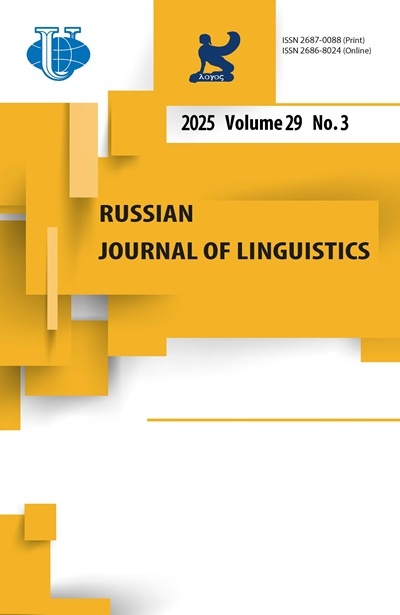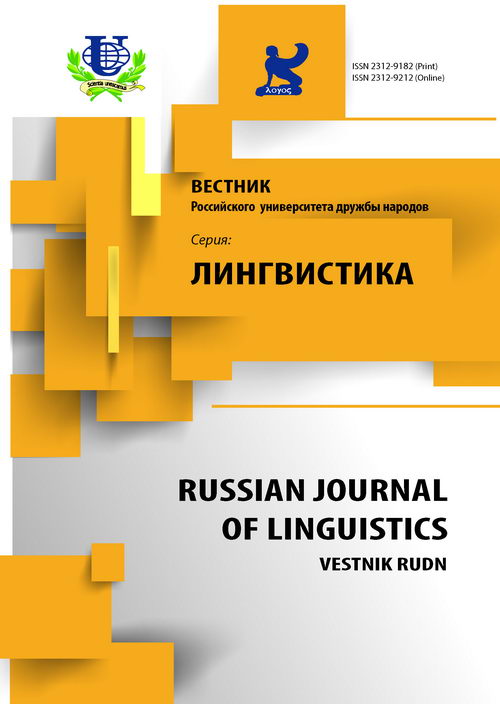Теория структурного взаимодействия: концептуальные, контекстуальные и стратегические определяющие коммуникации
- Авторы: Биби С.А1
-
Учреждения:
- Университет штата Техас
- Выпуск: Том 19, № 4 (2015)
- Страницы: 17-32
- Раздел: Статьи
- URL: https://journals.rudn.ru/linguistics/article/view/9254
- ID: 9254
Цитировать
Полный текст
Аннотация
В статье описывается Теория структурного взаимодействия (ТСВ), в рамках которой рассматриваются коммуникативные сообщения и предлагаются способы улучшения коммуникации, основанные на выборе наиболее предпочтительной для реципиента структуры сообщения или способа взаимодействия. Хотя Теория структурного взаимодействия является новой, она уходит корнями в такие классические науки, описывающие коммуникацию, как риторика и диалектика (Аристотель, 1959), а также современные теории коммуникации (Салем, 2012; Литтлджон, Фосс 2008). В статье даются основные положения Теории структурного взаимодействия, показано, как она может помочь объяснить и предсказать ход коммуникации в разных контекстах (в межличностной, групповой и общественной коммуникации) и определить стратегии, нацеленные на улучшение общения (что обсуждалось на конференции Российской коммуникативной ассоциации). Согласно Теории структурного взаимодействия, для того, чтобы сообщение было понято и достигло цели говорящего, необходим баланс двух составляющих: структуры и взаимодействия. Структура коммуникации - неотъемлемый элемент, участвующий в донесении информации до собеседника. Согласно описанию Аристотеля, в структуре связей и взаимодействия риторика является наиболее структурированной и четкой моделью передачи сообщения. Диалектика характеризуется более спонтанным обменом сообщениями. Согласно ТСВ, вся коммуникация может быть рассмотрена в рамках культурного взаимодействия. Данная работа иллюстрирует применение ТСВ к некоторым коммуникативным ситуациям и предлагает стратегии улучшения общения. В частности, рассматриваются возможности развития сообщений в соответствии с предпочтениями аудитории, основанными на коммуникативных ожиданиях и культурной специфике. Структура взаимодействия должна определяться запросами, интересами, ценностями (включая культурные ценности) аудитории, которые влияют на тип коммуникации.
Об авторах
Стивен А Биби
Университет штата Техас
Email: sbeebe@txstate.edu
Кафедра коммуникативных исследований
Список литературы
- Amichai-Hamburger, Y (2005). The social net: Human behavior in cyberspace. Oxford, England: Oxford University Press.
- Anderson, G.M. (2007). A most poetent rhetoric: C.S. Lewis, ‘congenital rhetorician’ In (Eds.) Edwards, B.E. C.S. Lewis: Life, works, and legacy. Westport, Connecticut: Praeger.
- Aristotle (1959). Ars rhetorica (Ed.) Ross, W.D. Oxford: Oxford University Press.
- Bakhtin, M.M. (1930/1981). The dialogic imagination: Four essays. (Ed.) Holquist, M. (Trans.) Emerson, C & Holquist, M. Austin and London: University of Texas Press.
- Bateson, G. (1958). Naven (2nd ed.). Stanford: Stanford University Press. (Original work published 1936). See: Salem, P. (1912). The complexity of human communication. New York: Hampton Press.
- Baxter, L.A. (1988). Dialectical contradictions to relationship development, in Handbook of personal relationships, (Ed.) Duck, S.W. Chichester, England: Wiley, 257-273.
- Baxter, L.A. and Montgomery, M., (1997). Rethinking communication in personal relationships from a dialectical perspective, in Handbook of personal relationships, 2nd ed., (Ed.) Duck, S.W. Chichester, England: Wiley, 325-349.
- Beebe, S.A. & Beebe, S.J. (2015). Public speaking: An audience-centered approach. Boston: Pearson.
- Beebe, S.A., Beebe S.J. & Ivy, D.K. (2013). Communication: Principles for a lifetime. Boston: Pearson.
- Beebe, S.A. & Masterson, J.T. (2015). Communicating in small groups: Principles and practices. Boston: Pearson.
- Beebe, S.A., Beebe, S.J. & Redmond, M.V. (2014). Interpersonal communication: Relating to others. Boston: Pearson.
- Berg, D.M. (1967). A descriptive analysis of the distribution and duration of themes discussed by task-oriented small groups. Speech Monographs 34, 172-75.
- Bryant, D.C. (1953). Rhetoric: Its function and its scope. Quarterly Journal of Speech 39.
- Buber, M. (1958). I and thou. New York: Scribners.
- Dance, F.E. X. & Larson, C. (1972). Speech communication: Concepts and behavior. New York: Holt, Rinehart and Winston.
- Flam, J. (2013). Matisse in the cone collection: The poetics of vision. Baltimore: The Baltimore Museum of Art.
- Fisher, B.A. (1970). Decision emergence: Phases in group decision making. Speech Monographs 37, 60.
- Gersick, C.J. (1989). Time and transition in work teams: Toward a new model of group development, Academy of Management Journal 32, 274-309.
- Giddens, A. (1984). The construction of society. Berkeley: The University of California Press.
- Hall, E.T. (1976). Beyond culture. New York: Anchor Books.
- Hofstede, G. (1991). Cultures and organizations: Software of the mind. London: McGraw-Hill.
- Hopthrow, T & Hulbert, L.G. (2005). The effect of group decision making on cooperation in social dilemmas, Group Processes and Intergroup Relations 8, 89-100.
- Kennedy, G.A. (1980). Classical rhetoric and its Christian and secular tradition from ancient to modern times. Chapel Hill, NC: University of North Carolina Press.
- Kerr, N.L. & Tindale, R.S. (2004). Group performance and decision making, Annual Review of Psychology 55, 623-655.
- Littlejohn, S.W. & Foss, K.A. (2008). Theories of human communication. Belmont, CA: Thompson Wadsworth.
- Pavitt, C, Philipp, M & Johnson, K.K. (2004). Who owns a group’s proposals: The initiator or the group as a whole? Communication Research Reports 21, 221-230.
- Poole, M.S. (1983). Decision development in small groups III: A multiple sequence model of group decision development, Communication Monographs 50, 321-341.
- Poole, M.S., Seibold, D.R. & McPhee, R.D. (1996). A structurational approach to theory building in group decision-making research. (eds.) Hirokawa, R.Y & Poole, M.S. Communication and group decision-making, (2nd ed.) Thousand Oaks, CA: Sage.
- Raymo, C. (2008). When god is gone everything is holy: The making of a religious naturalist. New York: Ave Maria Press.
- Salem, P.J. (2012). The complexity of human communication. (2nd ed.). New York: Hampton Press.
- Sproull, I &Kiesler, S. (1986) Reducing social context cures: Electronic mail in organizational communication, Management Science 32, 1492-1513.
- Stewart, J. (2013). U & Me: Communicating in moments that matter. Chagrin Falls, OH: Taos Institute publications.
- Sunwolf & Seibold, D.R. (1999). The impact of formal procedures on group processes, members, and task outcomes, in Frey, L. (Ed.). The Handbook of Group Communication Theory and Research. Thousand Oaks, CA: Sage, 395-431.
- Tidwell, L.C. & Walter, J.B. (2002). Computer-mediated communication effects on disclosure, impressions, and interpersonal evaluations: Getting to know one another a bit at a time, Human Communication Research 28, 317-348.
- Trevino, L.K., Daft, R. L, & Lengel, R.H. (1990). Understanding mangers’ media choices: A symbolic interactions perspective, in Fulk, J. & Steinfield, C. (Eds.). Organizations and Communication Technology. Newbury Park, CA: Sage, 71074.
Дополнительные файлы















